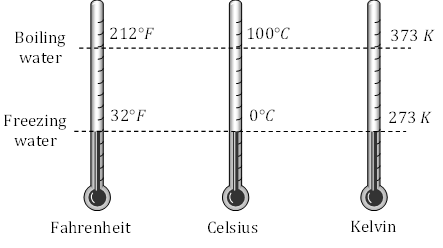
Scales of Temperature

The centigrade (°C), Farenheite (°F), Kelvin (K), Reaumer (R), Rankine (Ra) are commonly used temperature scales.
- To construct a scale of temperature, two fixed points are taken. First fixed point is the freezing point (ice point) of water, it is called lower fixed point (LFP). The second fixed point is the boiling point (steam point) of water, it is called upper fixed point (UFP).
- Celsius scale : In this scale LFP (ice point) is taken 0° and UFP (steam point) is taken 100°. The temperature measured on this scale all in degree Celsius (°C).
- Farenheite scale : This scale of temperature has LFP as 32°F and UFP as 212°F. The change in temperature of 1°F corresponds to a change of less than 1° on Celsius scale.
- Kelvin scale : The Kelvin temperature scale is also known as thermodynamic scale. The triple point of water is also selected to be the zero of scale of temperature. The temperature measured on this scale are in Kelvin (K).
- The triple point of water is that point on a P-T diagram where the three phases of water, the solid, the liquid and the gas, can coexist in equilibrium.
Different measuring scales
|
Scale |
Symbol for each degree |
LFP |
UFP |
Number of divisions on the scale |
|
Celsius |
°C |
0°C |
100°C |
100 |
|
Fahrenheit |
°F |
32°F |
212°F |
180 |
|
Reaumer |
°R |
0°R |
80°R |
80 |
|
Rankine |
°Ra |
460 Ra |
672 Ra |
212 |
|
Kelvin |
K |
273.15 K |
373.15 K |
100 |
- Temperature on one scale can be converted into other scale by using the following identity.
 = Constant for all scales
= Constant for all scales
(6) All these temperatures are related to each other by the following relationship

or 
- The Celsius and Kelvin scales have different zero points but the same size degrees. Therefore any temperature difference is the same on the Celsius and Kelvin scales (T2 – T1)°C = (T2 – T1) K.
Leave a Reply